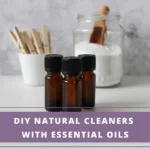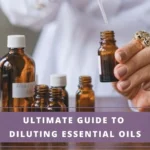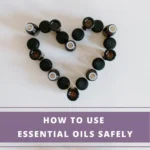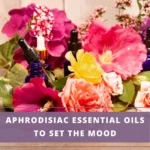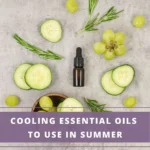As an Amazon Associate I earn from qualifying purchases. See Full Disclosure Here
Making your own calendula oil is easy and only requires a few easily available ingredients. This all-natural oil is loaded with ingredients that are beneficial for the skin.
Calendula oil benefits run the gamut from moisturizing dry skin and soothing minor skin irritations to reducing inflammation and healing minor cuts and scrapes faster. It is also gentle enough to use on a baby’s skin.
 What Is Calendula Oil?
What Is Calendula Oil?
Calendula oil is also known as calendula-infused oil. It is made using the same technique used to make other herb-infused oils.
To make calendula-infused oil, dried flowers from the Calendula officinalis plant are steeped in a carrier oil such as olive or almond oil. Calendula flowers are also known as pot marigold.
The calendula flowers are left to steep in the oil for about four to six weeks. During this time the natural active resins within the calendula flowers are extracted and drawn into the oil.
The result is a versatile and healing oil wide range of uses. Calendula oil benefits stem from its proven anti-inflammatory, antifungal, and antibacterial properties. It has been used for centuries to treat various skin conditions and is often added to natural skincare products.
Ingredients For Making Calendula Infused Oil
This calendula oil recipe makes about 1 cup of infused oil.
A handful of Dried Calendula Flowers (either whole flowers or petals)
1 cup Organic Carrier Oil
Glass Jar with Tightly-Fitting Lid
The calendula recipe uses only three ingredients but I did want to emphasize the importance of choosing each one carefully.
Tips For Buying Calendula Oil Ingredients For Best Results
How To Buy Calendula Flowers
Dried calendula flowers will give you the best results. Your homemade calendula oil will be concentrated and also have a longer shelf life.
Avoid using fresh calendula flowers. If you grow your own flowers, dry them before using them to make this infused oil.
Fresh flowers have a higher water content. This will cause the oil to be more diluted. The presence of water also increases the risk of the oil turning rancid. It also increases the risk of bacterial growth and reduces the shelf life of the infused oil.
If you do use fresh flowers, make only a small quantity and use it up quickly.
How to choose the Best carrier oil
I’ve used argan oil in my recipe but there are other carrier oils you can use too. Here are a few tips on how to choose the best carrier oil depending on your skin type.
Non-comedogenic oil is light, non-greasy, and least likely to clog your pores. It is a great choice for facial applications, especially if you have oily skin.
Comedogenic carrier oils are heavier and extra moisturizing, making them a better option for dry skin and for applying over your hands, feet, and body. Use sparingly on the face to avoid clogging pores. Better still,
For normal skin, I would mix a couple of oils to create a custom oil that has the benefits of both.
Argan Oil is my preferred choice when infusing calendula in oil. It is non-comedogenic, highly moisturizing, and excellent for reducing fine lines and wrinkles.
Very low on the comedogenic scale, Grapeseed Oil is a great choice for oily skin. It is lightweight, absorbs into the skin easily, and is non-greasy so it nourishes from the inside without leaving the skin looking oily.
Although slightly more comedogenic, Jojoba Oil is a great choice for combination and oily skin. This is because it is non-greasy, lightweight, absorbs easily, and works to reduce excess sebum.
Rosehip Oil is lightweight, rich in essential fatty acids, and Vitamins A & E, and absorbs easily into the skin. This is the best carrier oil for reducing discoloration and fine lines, soothing rosacea irritation, and healing scars.
Highly moisturizing, Sweet Almond Oil is the best carrier oil for sensitive and dry skin. It also helps to soothe inflamed skin due to eczema and acne.
Extremely hydrating and nourishing Extra Virgin Olive Oil is excellent for very dry skin and aging skin. The oil contains hydroxytyrosol, a rare antioxidant that protects the skin from free radical damage and slows down aging. It’s best not to use this oil on the face as it may be too heavy for delicate facial skin and may cause acne breakouts.
Fractionated Coconut Oil is highly comedogenic but it’s also highly moisturizing and hydrating,. It’s great for use on dry skin all over but best to avoid the face area. The oil is rich in compounds that give it strong anti-inflammatory, and antimicrobial properties, which are beneficial for the skin.
Regardless of your choice of carrier oil, it’s important to buy only high-quality, unrefined, cold-pressed oil from a reputed company. Don’t compromise on this. A poor-quality oil will not give the healing benefits you’re looking for.
Best type of jar for making herb-infused oils
It’s best to use a glass jar for making any type of herb-infused oils. Glass is non-reactive and will keep all the ingredients pure and uncontaminated.
Avoid using plastic jars as they could contaminate the oil.
The size of the jar will depend on the quantity of the ingredients. What you do want to make sure is that there is sufficient space to add oil above the level of the flowers. The flowers must be fully submerged in carrier oil.
2 Ways To Make Calendula Oil
 I’ve included two methods for infusing calendula in oil. The first is the traditional method but you have to wait about 4 weeks before you can use it. I prefer this technique as it preserves the delicate natural compounds found in calendula.
I’ve included two methods for infusing calendula in oil. The first is the traditional method but you have to wait about 4 weeks before you can use it. I prefer this technique as it preserves the delicate natural compounds found in calendula.
The second method is faster but it does damage some of the delicate compounds because it uses heat to accelerate the process.
Method 1 – Traditional Way To Make Calendula Oil
1. Place the completely dried calendula flowers into a clean, dry glass jar. You will want the flowers to be about half to three-quarters of the jar.
2. Pour your chosen carrier oil into the jar over the flowers. Add enough so that all the flowers are completely submerged. There should be about one inch of oil above of the flowers. The flowers do tend to float at first but they will settle to the bottom as they start absorbing the oil.
3. Cover the jar with a tight-fitting lid and shake it well so the ingredients mix well.
4. Cover the jar with a paper bag and place it in a warm, sunny place. The warmth helps the process but the direct sunlight is thought to destroy some of the delicate compounds found in calendula. The paper bag protects these compounds but prevents direct exposure to UV light.
5. Give the jar a gentle swirl at least once a day to allow the oil to cover the petals floating on top.
6. After 4 – 6 weeks, strain the infused oil into a clean, dry, glass bottle using a clean, dry cheesecloth or coffee filter. Squeeze the cheesecloth so you don’t waste any of this valuable homemade calendula oil. That’s it! Your homemade calendula–infused oil is ready to use!
7. Store your homemade infused oil in a dark, cool cabinet and use as needed. Better still, pour a small amount in a smaller bottle and keep it on your bathroom counter where it’s handy for everyday use.
Method 2 – How to make calendula oil fast
You’ll need a slow cooker for this method. Follow steps 1- 3 as above.
Place the closed jar in a slow cooker resting on a kitchen towel. Add water up to about the level of half the jar.
Set the slow cooker for two to six hours on the lowest setting. Place the lid on to help it warm up faster and retain heat better but check on it occasionally. If it’s too warm, remove the lid to avoid overheating.
After it cools, strain the calendula oil into a clean, glass jar using a cheesecloth or coffee filter and store in a cool, dark place.
Calendula Infused Oil Shelf Life & Storage
Once you’ve strained out the petals, it’s best to store the calendula oil in a cool, dry place to prevent premature damage.
The shelf life of your homemade infused oil will be the same as the shelf life of the carrier oil you used. Adding calendula leaves will not affect the storage life of the carrier oil.
Some carrier oils have a longer shelf life than others. You’ll find the date stamped on the bottle of the carrier oil. It’s a good idea to stick a label with a ‘Use By’ date on your homemade calendula oil bottle. Keeping it in the fridge can help extend the shelf life.
Don’t Have Time To Make Your Own Calendula Oil?
Not everyone has the time or inclination to make their own calendula-infused oil and that’s completely understandable. If you’re looking for premade options, here are a few that have gotten great reviews.
Herb Pharm Certified Organic Calendula Oil, 4 Fl Oz
Organic Calendula Carrier Oil by Herbal Choice Mari (16 Fl Oz Bottle) – No Toxic Synthetic Chemicals
Florida Herbal Pharmacy, Calendula (Marigold) Oil 3.4 oz. (100 ml)
Gya Labs USDA Calendula Oil Organic for Skin (1.02 oz) – 100% Natural Calendula Carrier Oil for Face
What Is Calendula Oil Good For?
Calendula oil is versatile and can be used for a variety of purposes. You can use it on its own or substitute it for regular carrier oil when making your own body creams, natural salves, or ointments.
The many ways you can use calendula oil will be primarily determined by the carrier oil you used.
9 Ways To Use Calendula Oil
1. Moisturize & Nourish Skin
Carrier oil infused with calendula is fantastic for moisturizing and nourishing your skin. Make sure to use the right carrier oil for your skin type. The oil is rich and luxurious, so you’ll need only a few drops to get the benefits.
2. Moisturize & Hydrate Dry Lips
Calendula-infused oil is one of the ingredients in many pre-made lip balms. You can use it by itself to hydrate and moisturize lips or use it instead of carrier oil when making your own lip balm.
3. Soothe Minor Skin Irritations
Rich in cooling, healing ingredients, calendula oil is very effective as a home remedy for minor skin irritations, scrapes, cuts, bug bits, and sunburn. It also helps soothe skin inflammation and redness associated with rosacea and eczema. If you have sensitive skin, pour some of the oil in a small glass bottle and carry it with you everywhere.
4. Use As a massage oil
Why use a carrier oil when you can use one fortified with calendula! When you use calendula-infused oil for a massage, you get the benefits of the massage as well as the infused oil.
5. Use As a facial cleanser
Using this infused oil to wash your face is so much better than using soap, especially if you have dry skin. It’s easy too. Gently massage your face with calendula oil for about a minute. Then place a warm, wet washcloth over your face for another minute. The warmth opens up your pores and draws out impurities. When the washcloth cools down, heat it again and repeat. Do this a couple more times before finally wiping it off with a moist towel to remove the excess oil. Not only will your skin feel cleaner, it will also feel softer and smoother after this.
6. Moisturize & Condition Dry, Frizzy Hair
Besides being good for the skin, carrier oil infused with calendula is excellent as a hair conditioner, especially for dry, frizzy hair. Gently massage the oil into the scalp and hair. Leave it for about 15 minutes or overnight for very dry hair. Shower off using a good, nourishing shampoo for dry hair. The best carrier oils for this purpose are olive, coconut, and argan oil.
7. Use As A Makeup Remover
If you’ve made a batch of calendula oil, go ahead and use it to remove makeup instead of a regular carrier oil. Make sure you’re using the right carrier oil for your face type and be careful when using about the eye area.
8. Add as an Ingredient in other homemade skincare products
If you enjoy making your own skincare products, substitute plain carrier oil with calendula-infused oil in the recipes. Use it as a base to make super-nourishing skin creams, body butters, soaps, lotion bars, salves, ointments, and more. You can then scent them with a few drops of essential oil.
9. Give it as a gift
We often overlook this simple idea so I wanted to add it to this list. If you decide to go with this idea, make a large batch and start early so the oil has time to infuse. Fill the infused oil in smaller glass containers, use a decorative label and add a flourish to the bottle for a special touch. Include a little hand-made card with instructions on how to use it.
Precautions when using calendula oil
Calendula has been listed as a Safety Class 1 A herb in the Botanical Safety Handbook. This is one of the safest ratings possible.
Still, there are a few precautions you must keep in mind regarding its use.
If you’re allergic to ragweed, there’s a higher chance you’ll also have an allergic reaction to this herb. Do a test patch or avoid it altogether if you’re severely allergic.
Some studies reported that ingesting calendula may stimulate menstruation. It’s best to avoid ingesting this herb if you’re pregnant. Topical use may be safe but I would definitely avoid it. You never want to take that risk.
Last but not least, always check with your healthcare provider before using any type of herbal remedy.
Calendula Oil FAQs
Can I use the whole flowers or only the petals?
You can use either as long as they are fully dried. You’ll get a less potent infused oil by using only the petals. When you use the whole dried flower with the green base, you’ll get a more potent oil.
Is marigold the same as calendula?
Calendula and common marigold belong to the same plant family but they are two different types of plants. Calendula is pot marigold. Its botanical name is Calendula officinalis.
Is calendula-infused oil a type of essential oil?
No, calendula-infused oil is not an essential oil. Essential oil is an extract of the volatile aromatic compounds found in the plant. Calendula is a fortified carrier oil, which is completely different from essential oil.
Can I add essential oils to my homemade calendula oil?
Yes, you can. If you’re using your homemade oil for rosacea, add these best essential oils for rosacea. If you’re adding essential oils, it’s best to transfer the contents to a small bottle and use it up. Then make a new batch. This helps to preserve the properties of the essential oils, which would otherwise get damaged from excessive exposure to air and light.
Related Reads:
Difference Between Infused Oils and Essential Oils
Organic Body Care Recipes: 175 Homemade Herbal Formulas for Glowing Skin & a Vibrant Self
How To Use Aloe Vera Gel For Face
 Disclaimer: This information is not intended to serve as medical advice. Please consult your doctor before using any natural medication or if you experience any unusual symptoms. See Full Disclaimer here.
Disclaimer: This information is not intended to serve as medical advice. Please consult your doctor before using any natural medication or if you experience any unusual symptoms. See Full Disclaimer here.


